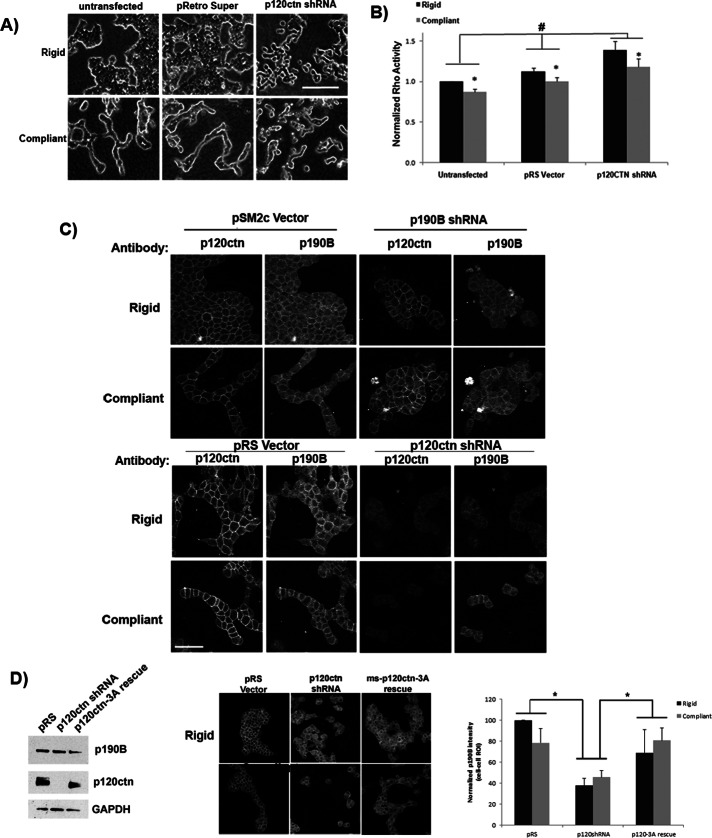FIGURE 4:
p120-catenin contributes to localizing p190RhoGAP-B to cell–cell contacts and to regulating activity of RhoA. (A) T47D cells expressing p120-catenin shRNA or the appropriate vector control plasmid were cultured in attached or floating 1.3 mg/ml collagen gels for 10 d. Phase contrast images show that shRNA against p120-catenin disrupts tubulogenesis in floating gels, as well as normal cell growth in attached collagen gels (scale bar, 100 μm). (B) In these cell lines, RhoA activity was down-regulated in T47D control cells and in p120-catenin shRNA cells cultured in compliant vs. rigid collagen gels (*compliant vs. rigid: untransfected, p = 0.0001; pRS, p = 0.0011; p120shRNA, p = 0.0464; n = 5). Of interest, p120-catenin is necessary for the proper level of RhoA activity in both compliant and rigid collagen gels, as RhoA activity is significantly elevated in p120-catenin shRNA–expressing cells compared with untransfected and vector control cells (*p120shRNA vs. untransfected, p = 0.0214; p120shRNA vs. pRS, p = 0.0141; n = 5). (C) Top, Immunofluorescence analysis of p120-catenin localization in control and p190B shRNA cells. Knockdown of p190B did not alter the localization of p120-catenin in compliant or rigid collagen gels. Bottom, analysis of p190B localization in control vs. p120-catenin shRNA cells completed after culture in compliant and rigid collagen gels. In contrast to p190B shRNA cells, knockdown of p120-catenin results in the visible loss of p190B at cell–cell contacts. (D) Western blot analysis confirmed that the total level of p190B was not altered in control, human-specific p120-catenin-shRNA or mouse p120-catenin-3A rescue cell lines. z was used as a loading control. Quantification of p190B immunofluorescence in regions of interest demonstrate a significant decrease in p190B intensity at sites of cell–cell contact in both rigid and compliant collagen gels when p120-catenin is knocked down (scale bar, 100 μm; *rigid and compliant pRS vs. p120-catenin shRNA, p = 0.004; n = 9 fields of cells in three experiments). The localization of p190B to cell–cell contacts was restored to 75% of control levels and significantly increased above knockdown levels upon rescue of p120-catenin with mouse p120CTN-3A (*rigid and compliant: p120-catenin shRNA vs. mouse-p120CTN-3A rescue, p = 0.042; n = 9 fields of cells in three experiments).

